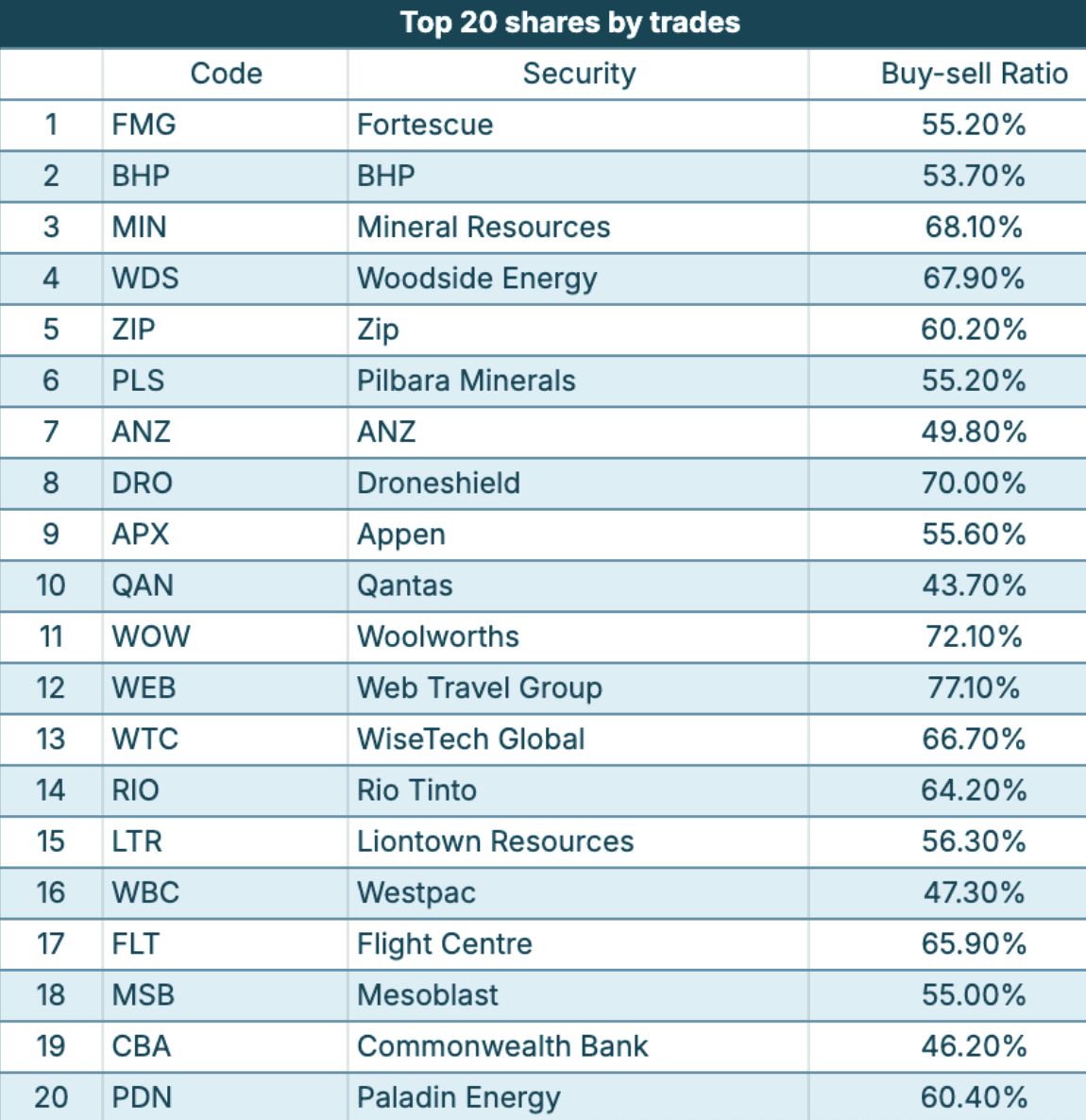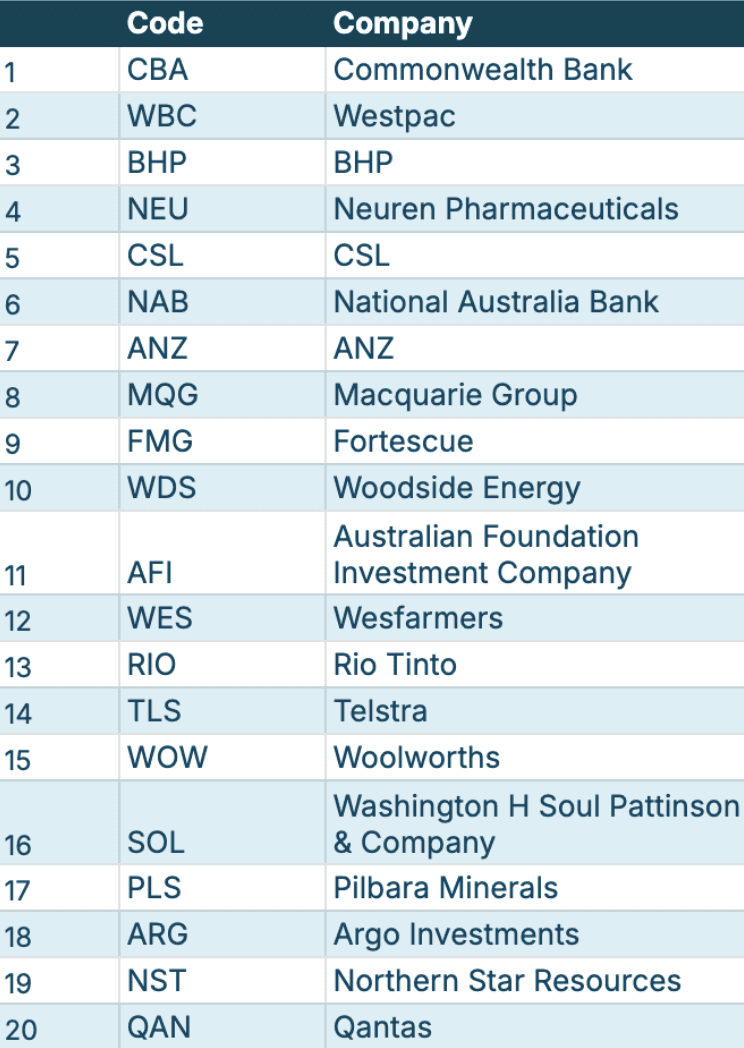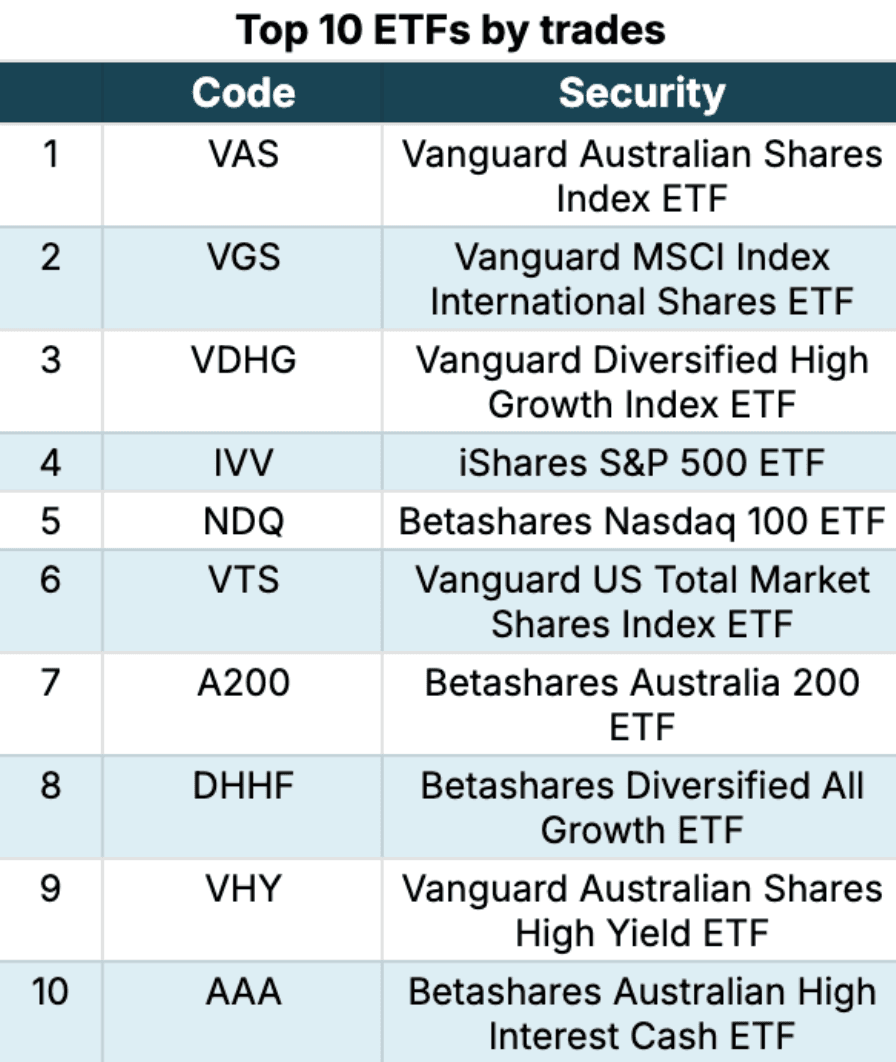Selfwealth most traded ASX shares: October 2024
Rene Anthony
Key takeaways:
While the ‘Big Four’ gained support from the market last month, Selfwealth community holdings in these names outpaced underlying share price gains.
By money flow, Fortescue posted its first month of net outflows since April 2024.
Selfwealth trade volume conviction increased for ETFs tracking ASX shares.
Past performance is not an indicator of future performance you should always undertake your own research.
While the ASX set a record high in October, that benchmark failed to hold through the month. In fact, the S&P/ASX 200 declined 1.3% over the period, largely influenced by overseas markets.
Financials outperformed, but even with the local market’s heavy weighting towards this sector, it was not enough to overcome the large drag from the likes of the Energy, Utilities, and Consumer Staples sectors.
ASX share trading activity
The top 20 for the most traded shares on the platform last month was populated by numerous familiar names, but the list also included several companies making headlines in the news, and others exposed to difficult operating conditions.
For the third time in as many months, Mineral Resources (ASX: MIN) climbed higher, taking out third spot. In September, MIN was ranked sixth, and before that, 14th in August.
Woodside Energy (ASX: WDS) was the fourth most traded ASX share in October. More than two-thirds of all trades were ‘buys’, which coincided with the stock circling a yearly low. Lower oil prices were a headwind for the company. It was not the first time we have seen buying support from the Selfwealth community during periods of share price weakness for the ASX blue-chip share.
On a different note, Webjet completed its demerger at the start of October. The company’s operations are now split between Web Travel Group (ASX: WEB) and Webjet Group (ASX: WJL). However, it was an update by the former that caught the market’s attention, with shares plummeting over 30% in a single session.
The catalyst for that drop was a first-half trading update that pointed to several headwinds weighing on WEB’s margins, and a corresponding downgrade. Nonetheless, the sell-off was treated as a buying opportunity by many Selfwealth investors. In total, 77.1% of last month’s trades were ‘buys’ — a figure higher than any other stock in the top 20.
Rounding out the top 20 was Paladin Energy (ASX: PDN). Like most other high volume trades last month, PDN was the subject of a sell-off. Late in the month, the company’s share price slumped 21%. As it were, the sell-off coincided with a trading update that highlighted various operational challenges as production ramped up at Paladin’s LHM Project in Namibia.
Other popular trades that have whipsawed through the list over recent months include Pilbara Minerals (ASX: PLS), ranking sixth last month, Droneshield (ASX: DRO), eighth, Appen (ASX: APX), ninth, Flight Centre (ASX: FLT), 17th, and Mesoblast (ASX: MSB), 18th.

In findings that somewhat contrast overall ETF holdings-related growth on the platform last month, there was no discernible change in conviction related to global equities ETFs. In fact, ASX-related funds saw a marked increase in buying when it came to trade volumes.
What may seem like a contradiction can be explained by the fact that while trade volume conviction rose for ASX-tracking funds, the balance of money flow behind said trades generally lagged that of the funds focusing on overseas markets.
Nonetheless, as far as trade volumes, buying conviction in Vanguard Australian Shares Index ETF (ASX: VAS) surged over 10 percentage points to 83.7%. The same metric rose from 74.8% to 84% for the Betashares Australia 200 ETF (ASX: A200).
Among the top 10, the fund with the highest buying conviction for trade volumes was the Betashares Diversified All Growth ETF (ASX: DHHF) at 87%.
Despite topping the list for money flow, Fortescue (ASX: FMG) recorded net monthly outflows for the first time since April this year. For the second straight quarter, the market sold down FMG in the immediate aftermath of its quarterly production report. On the Selfwealth platform, 51.3% of funds tied to FMG trades were associated with selling activity.
By money flow, Westpac (ASX: WBC) also fared better than its ‘Big Four’ peers, while there was a net positive for money flow into the likes of Zip (ASX: ZIP), ranking 10th, and Woolworths (ASX: WOW), 13th. In contrast, AGL Energy (ASX: AGL) recorded net outflows, making it one of just a handful of names where the community, overall, pulled money out of the stock.
What are the most popular ASX shares and ETFs?
Bank shares were one of the key segments that saw an uplift in holdings through October. This was in contrast with September’s trading activity, where investors showed signs of ‘rotating’ out of banks.
Each of the ‘Big Four’ recorded mid-to-high single digit growth in community holdings across the month. This resulted in Westpac taking out second spot among the most held names (by value) on the Selfwealth platform, lagging only Commonwealth Bank (ASX: CBA).
Of the four bank shares, Westpac also enjoyed the largest uplift in growth relative to its underlying share price performance for the month. This finding corresponds with the data presented above on money flow, where Westpac outperformed its peers despite trade volumes being weighted towards selling.
At the other end of the scale, the biggest uplift was recorded by Northern Star Resources (ASX: NST) — a share making only its second-ever appearance among the top 20. Gold prices were seen running higher into the month’s end, almost hitting US$2,800 per ounce.
The record gold price was likely due to investors seeking a haven ahead of the US election, and with the Federal Reserve expected to continue cutting interest rates. NST shares gained 11% in October, but community holdings grew 17%, highlighting support for the gold miner within the Selfwealth community.
Another trend that reversed course through October was growth aligned with mining stocks. Momentum from September faltered, and it resulted in the likes of BHP (ASX: BHP), Fortescue (ASX: FMG), and Pilbara Minerals (ASX: PLS) all recording a decline in Selfwealth holdings. Nonetheless, on each instance, the decline was less than the underlying share price weakness — suggesting some Selfwealth investors may have engaged in opportunistic buying.

ETFs with exposure to global equities currently hold a strong presence across the Selfwealth community. Five of the top six names from this segment offer at least some exposure to international markets.
This includes the Vanguard MSCI Index International Shares ETF (ASX: VGS), which features in more than 14,000 unique Selfwealth portfolios across the platform.
Meanwhile, global funds like the Betashares Nasdaq 100 ETF (ASX: NDQ) and the Vanguard US Total Market Shares Index ETF (ASX: VTS) both gained a place on account of favourable money flow, as touched on earlier. The two ETFs feature in approximately 12,000 and 5,500 Selfwealth investors’ portfolios respectively.

That’s all for this Trade Trends report, stay tuned for the next edition this time next month.
Important disclaimer: SelfWealth Ltd ABN 52 154 324 428 (“Selfwealth”) (AFSL 421789). The information contained on this website is general in nature and does not take into account your personal situation. You should consider whether the information is appropriate to your needs, and where appropriate, seek professional advice from a financial adviser and/or accountant. Taxation, legal and other matters referred to on this website are of a general nature only and should not be relied upon in place of appropriate professional advice. You should obtain the relevant Product Disclosure Statement for any product mentioned and consider its contents before making any decision.





